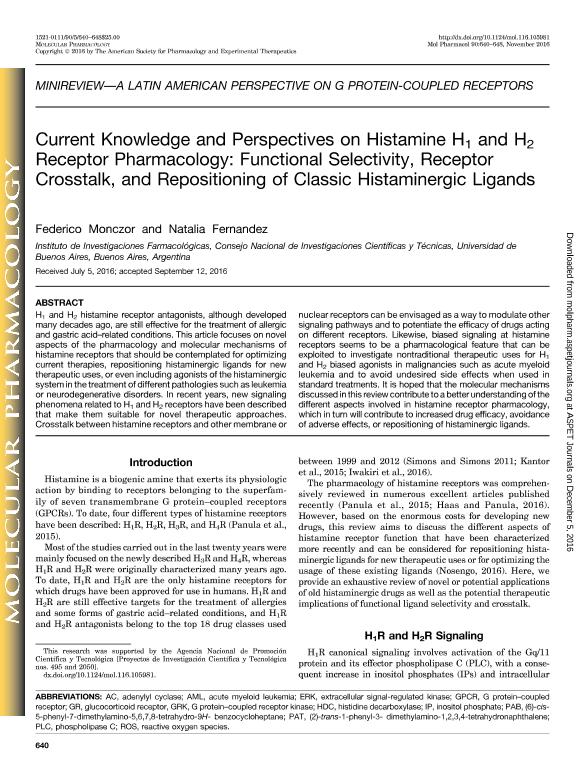Mostrar el registro sencillo del ítem
dc.contributor.author
Monczor, Federico

dc.contributor.author
Fernandez, Natalia Cristina

dc.date.available
2018-03-28T19:26:02Z
dc.date.issued
2016-11
dc.identifier.citation
Monczor, Federico; Fernandez, Natalia Cristina; Current knowledge and perspectives on histamine H1 and H2 receptor pharmacology: Functional selectivity, receptor crosstalk, and repositioning of classic histaminergic ligands; American Society for Pharmacology and Experimental Therapeutics; Molecular Pharmacology; 90; 5; 11-2016; 640-648
dc.identifier.issn
0026-895X
dc.identifier.uri
http://hdl.handle.net/11336/40457
dc.description.abstract
H1 and H2 histamine receptor antagonists, although developed many decades ago, are still effective for the treatment of allergic and gastric acid-related conditions. This article focuses on novel aspects of the pharmacology and molecular mechanisms of histamine receptors that should be contemplated for optimizing current therapies, repositioning histaminergic ligands for new therapeutic uses, or even including agonists of the histaminergic system in the treatment of different pathologies such as leukemia or neurodegenerative disorders. In recent years, new signaling phenomena related to H1 and H2 receptors have been described that make them suitable for novel therapeutic approaches. Crosstalk between histamine receptors and other membrane or nuclear receptors can be envisaged as a way to modulate other signaling pathways and to potentiate the efficacy of drugs acting on different receptors. Likewise, biased signaling at histamine receptors seems to be a pharmacological feature that can be exploited to investigate nontraditional therapeutic uses for H1 and H2 biased agonists in malignancies such as acute myeloid leukemia and to avoid undesired side effects when used in standard treatments. It is hoped that the molecular mechanisms discussed in this reviewcontribute to a better understanding of the different aspects involved in histamine receptor pharmacology, which in turn will contribute to increased drug efficacy, avoidance of adverse effects, or repositioning of histaminergic ligands.
dc.format
application/pdf
dc.language.iso
eng
dc.publisher
American Society for Pharmacology and Experimental Therapeutics

dc.rights
info:eu-repo/semantics/openAccess
dc.rights.uri
https://creativecommons.org/licenses/by-nc-sa/2.5/ar/
dc.subject
Repourposing
dc.subject
Cross-Talk
dc.subject
Histamine
dc.subject
Biased
dc.subject.classification
Inmunología

dc.subject.classification
Medicina Básica

dc.subject.classification
CIENCIAS MÉDICAS Y DE LA SALUD

dc.title
Current knowledge and perspectives on histamine H1 and H2 receptor pharmacology: Functional selectivity, receptor crosstalk, and repositioning of classic histaminergic ligands
dc.type
info:eu-repo/semantics/article
dc.type
info:ar-repo/semantics/artículo
dc.type
info:eu-repo/semantics/publishedVersion
dc.date.updated
2018-03-28T14:10:34Z
dc.journal.volume
90
dc.journal.number
5
dc.journal.pagination
640-648
dc.journal.pais
Estados Unidos

dc.journal.ciudad
Baltimore
dc.description.fil
Fil: Monczor, Federico. Consejo Nacional de Investigaciones Científicas y Técnicas. Oficina de Coordinación Administrativa Houssay. Instituto de Investigaciones Farmacológicas. Universidad de Buenos Aires. Facultad de Farmacia y Bioquímica. Instituto de Investigaciones Farmacológicas; Argentina
dc.description.fil
Fil: Fernandez, Natalia Cristina. Consejo Nacional de Investigaciones Científicas y Técnicas. Oficina de Coordinación Administrativa Houssay. Instituto de Investigaciones Farmacológicas. Universidad de Buenos Aires. Facultad de Farmacia y Bioquímica. Instituto de Investigaciones Farmacológicas; Argentina
dc.journal.title
Molecular Pharmacology

dc.relation.alternativeid
info:eu-repo/semantics/altIdentifier/doi/http://dx.doi.org/10.1124/mol.116.105981
dc.relation.alternativeid
info:eu-repo/semantics/altIdentifier/url/http://molpharm.aspetjournals.org/content/90/5/640
Archivos asociados
